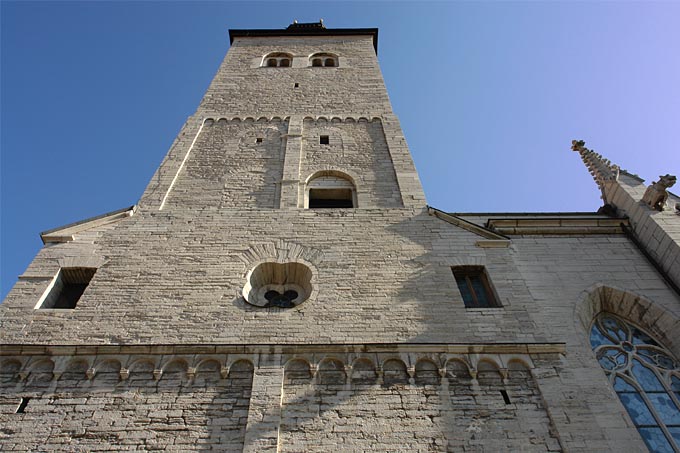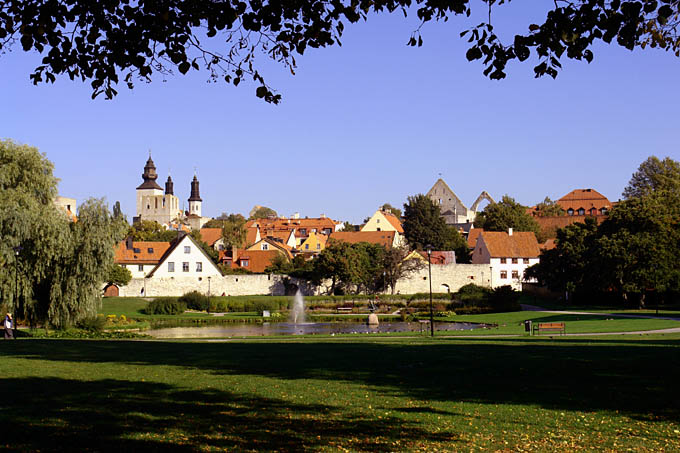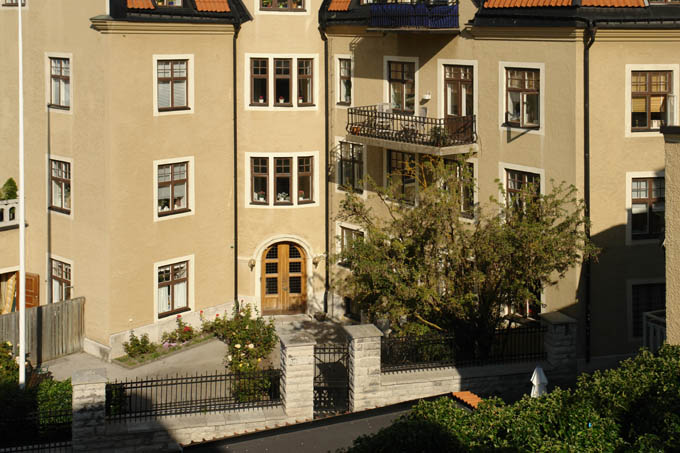Referenz: Visby
- Kleiner Exkurs -
|
|
|
A medieval town? Our town vs My house
Nothing but an old town? Back to the Kernel
|
|
|
This chapter is dedicated to my Norwegian friends - since the little old town of Visby seems to be quite unknown in Norway. The raison why I place this chapter after the “Nei til Tromsö” chapter is the identical harbour fee and the immense difference in taking care of an old town structure. In other words: “Let’s compare, what one gets for the same money.”
Today, Visby is the same kind of “fylke”-capital to the Island of Gotland as Tromsö is to Troms. (But no oil or gas nearby.)
Around 900, Gotland was an independent state. His population must have been independent farmers, capable to sail to Russia (Lake Ladoga, Nowgorod) and trade with nations in Asia. At that time, Visby began to develop as a very specific part of Gotland.
After three* different periods of wealth and importance it finally ended up as a place of little economic importance.
|
*Gotlandisk town (until 1167); independet town (1167-1356); Hanse town (from 1356)
|
|
|
|
|
Around the end of the 18th century some writers and painters discovered the forgotten town of Visby and attributed her the name “town of roses and ruines”.
The number of roses in the town is still abundant, the number of ruines is low now, since all run down houses are repaired. Only the ruines of about 15 churches and about 30 towers of the city wall remain.
|
|
|
|
|
|
This ruin of a convent church, St Nicholas (S:t Nikolei), is the background for the roses at the first photo. The walls and roofs are a little less then 800 years old. (Build around 1230 by , more than 100 years before the German Hanseatic league was founded.)
|
|
|
|
|
|
The construction of a city wall that was higher and thicker towards the land than towards the sea indicates that the enemy came from land and the city was already powerfull enough to organize and finance the erection of a 3,5 km long and up to 12 m high wall, reinforced by 44 towers. The work started at the beginning of the 13th century and was finished at the beginning of the 14th century.
The tower at the end of the street is Norderport, probably erected short after 1288, the year of a short civil war between the monopolistic organized town population from different european countries (most of them from Germany) and the independent farmers of Gotland, who lost that war.
The city is not a museum, everybody can reach his house by car. Nevertheless the traffic is hardly disturbing.
|
|
|
|
|
|
All streets kept their original dimensions. Small old wooden houses, intermixed with some simple stone houses are the dominant buildings in many parts of the old town.
The church in the background is the only one that was never destroyed: S:t Maria domkirka.
|
|
|

|
|
|
Many churches in Visby had a double funktion: to secure the long range future of the merchant and to secure his merchandise on a day to day scale. The walls of the cathedral St Marie give testimony of this type of redundancy.
|
|
|

|
|
|
A best known view of Visby. The little lake in the foreground was part of the medieval harbour, separated from the city by a wall. The three black towers belong to the cathedral St. Maria. The church ruin (St. Katarina) above the black lanterne mark the center of the town (Stora Torget).
For marketing reasons Visby is described as having gained his importance from the Hanse, but the strategic value and the wealth of the town was more outstanding before 1356.
“Visby functioned as the leading centre in the Baltic before the Hansa. It declined to become a member for 100 years. Finally, in 1358, it became one of the midwives of the Hanseatic league. Before the foundation of the league” (in 1358 or 1356? in Lübeck) “the word Hanse did not occur in the Baltic.” (Wikipedia English)
The end of the Hanse period is not clearly defined. One of the numerous dramatic events of this period happened 1525, when an army lead by the Hanse friends in Lübeck attacked Visby and destroyed parts of the town.
|
Five years after the Hanse foundation the Danish King Atterdag invaded Gotland (excactly for that reason). 9 years later the Hanse succeded# in defeating him (Treaty of Stralsund).
1645 Sweden forced Danmark to surrender Gotland, an island far away from the Swedish mainland.
The town was finally simply forgotten.
|
|
|
|
|
As in many other cities, the destroyer must not be an external enemy, it is an internal politician or architect. This church complex, St Hans and St. Peter was around 1500 still in good shape. Their end came around 1770, when the architect (Baumeister) Chemnitz needed cheap material for his own buildings. Short time later, cows used the area as meadow. Today, tourist get there coffee served in the ruines od St. Hans.
|
|
|
|
|
|
http://www.gotmus.i.se/databaser/visby-forr/innehallsforteckning.htm
|
|
|
S:t Hans kyrkoruin. Ännu i början av 1500-talet var S:t Hans kyrka i ganska gott skick. Under den efterföljande tiden förföll kyrkan alltmer. En allvarligare förödelse inträffade i samband med byggandet av det stora Lythbergska huset, S:t Hansplan 1, omkring 1770 då byggmästare J.N. Chemnitz tog sten från kyrkan. Samme byggmästare raserade även S:t Olofs kyrka då han byggde nuvarande Musikskolan i kv Ankaret 1.
På 1820-talet fanns inte mycket kvar av det en gång så stora kyrkokomplexet. Inne i kyrkan hade då byggts en stor ladugård med gaveln mot S:t Pers nordmur. Motivet sett från sydväst. lavering av M.G. Anckarswärd 1826.
|
|
|

|
|
A medieval town?
The inner town of Visby is a melting pot for houses of many ages and styles. Most of the houses you see today are not older then 200 or 300 years. 400 to 600 year old houses, build in the years of decline, are rare. The 700 or 800 year old churches and tradehouses and city wall towers are still present in great numbers.
|
|
|

|
|
|
The type of houses ranges from bourgois ...
|
|
|
|
|
|
... to tiny wooden houses, built by fishermen or artisans.
|
|
|
|
|
|
The number of restaurants, pubs, cafés is difficult to estimate, probably more than 200. (750.000 visitors per year; 23.000 inhabitants.)
|
|
|
|
|
|
The old main street (Adelsgatan, Hästgatan) between the southern and eastern town gate offers tourists the opportunity to spend their money.
|
|
|
|
|
|
The guest harbour (170+40 SEK/24 hours), where, in the main season, none of the houses in the background is visible:the water surface is completely covered by sailing boats. (Now it is late September)
|
|
|
|
|
|
The street that leads from the guest harbour to the center of the old town.
|
|
|

|
|
“Our Town” versus “My House”
|
|
|
The moment I read the panel (below) at the entrance to the Garden of the Freemason’s Hall (Freimarer) neighbouring the S:t Nicolai ruin, I realized that the text of the panel
- “... not normally open to the public. You are invited ...” and
- “... behave carefully and respect ...”
expresses best the difference I see between the current development in Sørlandet/Norway and e.g. Stockholms Skärgard including its clean public saunas.
|
|
|
|
|
|
The complete Text of the panel.
|
|
|

|
|
Nothing but an old town?
No. The area inside the medieval city wall is free of McDonalds, ICA, LINDEX, COOP, EXPERT and all these monoton sales channels. But outside the wall and defense fields# they are allowed to grow.
|
|
|
|
|
|
These flowers just outside Österport mark the beginning of the modern, unprotected part of Visby.
|
|
|
|
|
|
Österväg, the shopping area east of the Eastern Gate (Österport).
|
|
|
|
|
|
The harbour facilities are extended to handle at least two 200 m long ferries, which connect Gotland/Visby to the mainland. There cruising speed is 28,5 knots without beeing a katamaran. (8 tons fuel per hour)
|
www.destinationgotlan d.se
|
|
|
|
|
Due to the great attraction of the carefully protected area of Visby to all kind of visitors, the tourist and congress industrie continues to grow. A new congress hall will be ready in 2007. (It is located seawards of the town wall.)
|
|
|
|
|
|
A new entrance building for the Högskolan and a new (white) library building in the same area is already in use.
|
|
|

|
|
Back to the kernel
|
|
|
|
|
|
Södra Murgatan. Poor families liked to build their houses attached to the solid city wall. Most of the wall towers were used as warehouses or prisons for some decades. The material to build all these walls, towers and churches lies “ready to use” in the ground of Gotland.
|
|
|
|
|
|
Not many of these “only” 200 year old wooden houses are left. The first owner of this house would certainly be surprised to hear the price he would be asked to pay for his house today.
|
|
|
|
|
|
Another wooden house of a once poor family. It is decorated with#by the roses, you will see on the next photo.
|
|
|
|
|
|
OK, lets end this chapter with these flowers.
|
|
|
|
|
|
Zuletzt bearbeitet / korrigiert / erweitert / Verweise (links) getestet am: 2. November 2006
|
|
|
|
|


